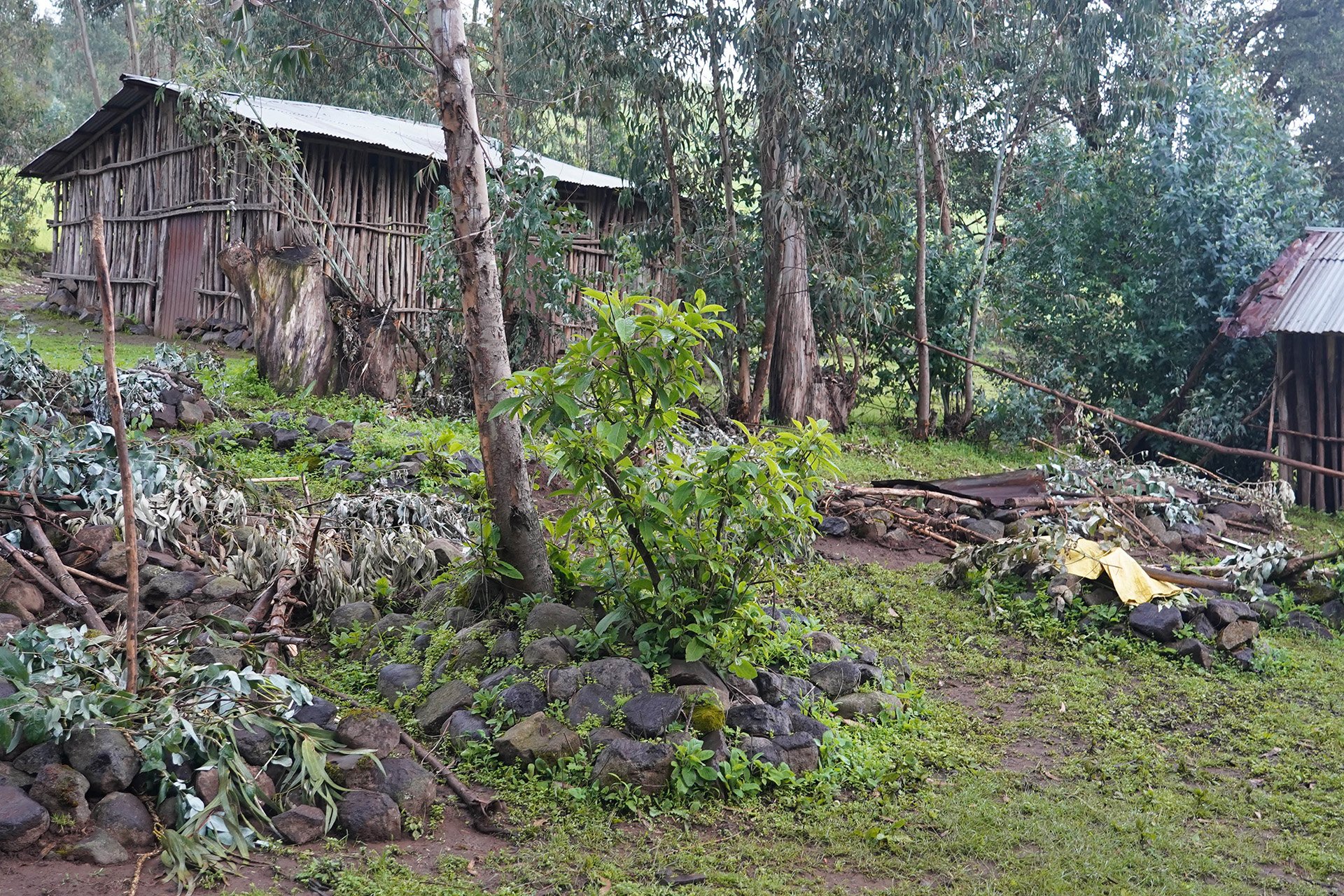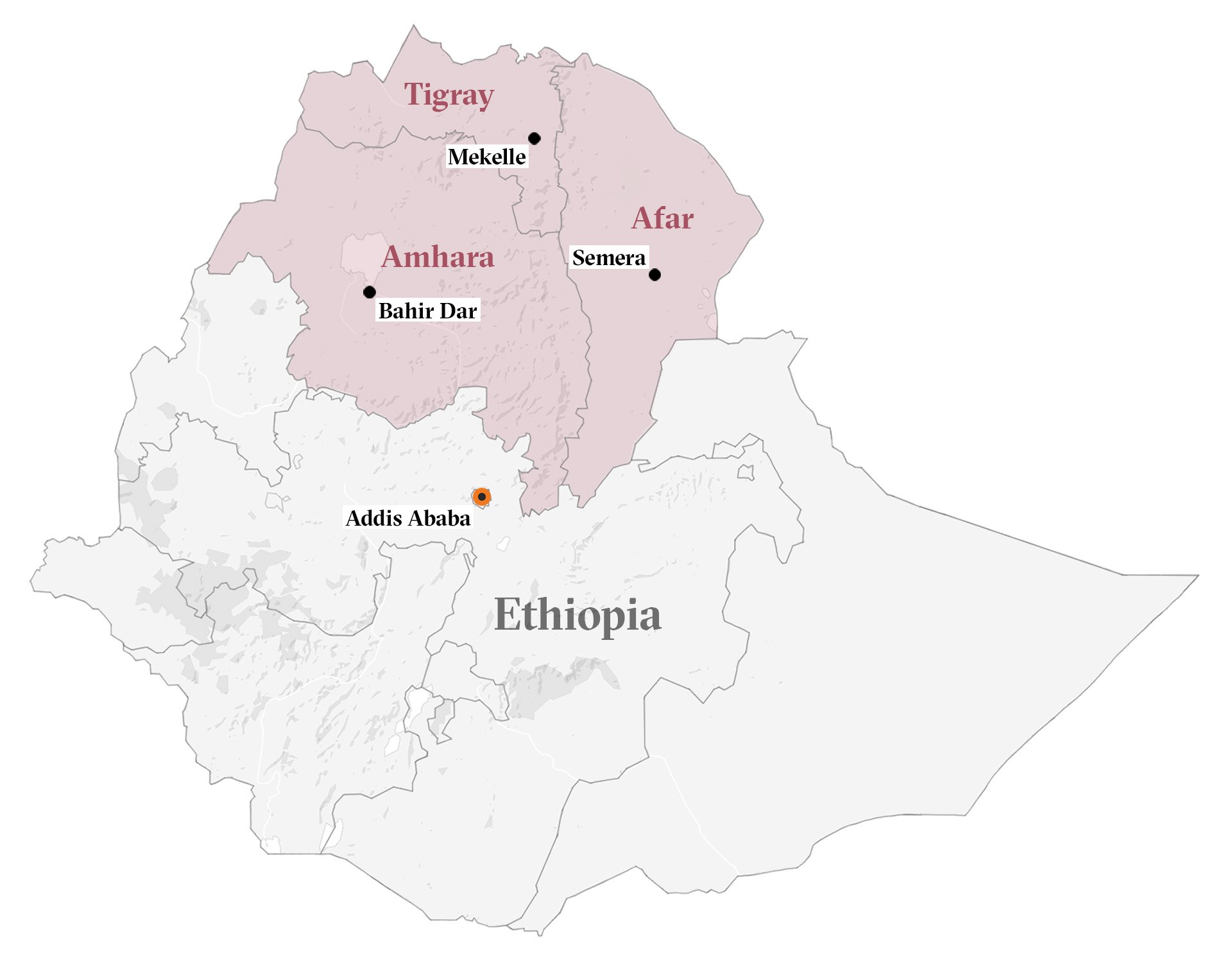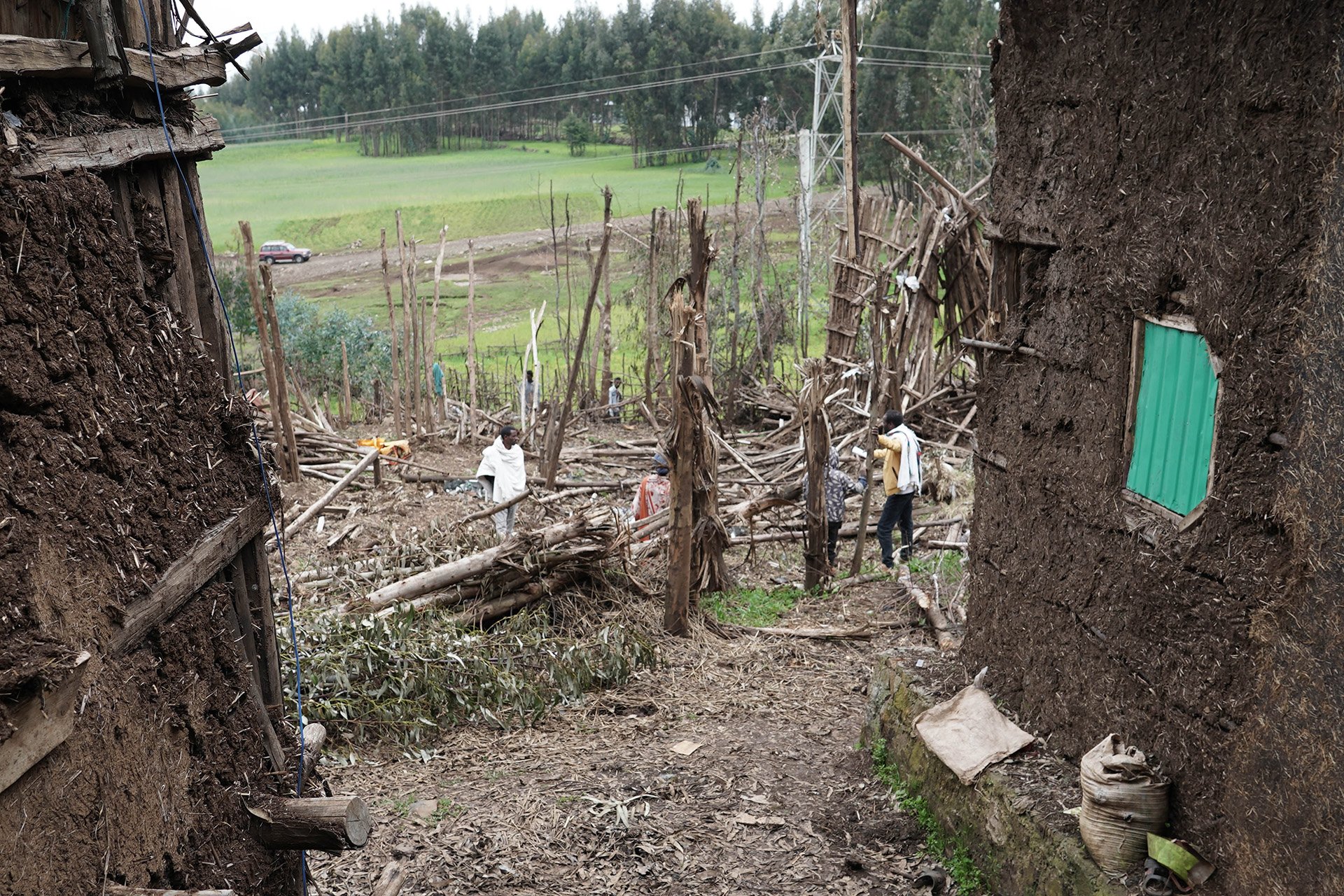An upturned rebel tank lay by the road, overlooking fields of wheat and barley. Dead bodies were slumped in bushes and on muddy highland trails. Dark grey stones and the branches of a eucalyptus tree concealed a hastily dug mass grave.
Rebels from Ethiopia’s Tigray have taken their fight into the neighbouring Amhara region, bringing with them reports of deadly clashes, abuses against civilians, and fears that fighting could intensify as the grounds for reconciliation with the government recede even further.
“I hid in a small room and stayed inside without eating for four days,” said Priest Mengistu from the Amhara village of Chenna Teklehaymanot, where local officials claim over 120 people were killed by Tigrayan rebels in the first week of September. “At first… they said they wouldn’t kill us, but when they [left the village], they started massacring.”
Government officials in Amhara said half a million people have been uprooted since Tigrayan rebels launched an offensive in the region – Ethiopia’s second most populous – in July. Tens of thousands have also been displaced in the northeastern Afar region, where rebels have spread their fight too.
On a visit to Amhara in early September, The New Humanitarian spoke to residents who recounted atrocities committed by Tigrayan forces, and others who spoke of disrupted livelihoods and dangerous journeys seeking places of refuge. The rebels have denied targeting civilians during their operations, blaming Amhara officials for mobilising people on mass to fight against them.
Humanitarian organisations, including the UN’s World Food Programme (WFP), told The New Humanitarian they are trying to scale up their operations in Amhara and Afar but face funding gaps and access constraints linked to ongoing fighting.
Aid groups are also facing growing hostility from Addis Ababa. Last week seven senior UN officials were deported for allegedly “meddling” in the country’s affairs. And two major international relief organisations have been suspended for more than two months.
“Currently, we need $140 million to scale up as needed in the three regions of northern Ethiopia and this will increase if the situation worsens,” said Gemma Snowdon, a communications officer for WFP.

Even before conflict spread across regional borders, aid groups were struggling to assist more than 5.2 million people in need of assistance within the Tigray region, where tensions between the regional ruling party, the Tigray People’s Liberation Front (TPLF), and the government exploded into conflict in November 2020.
TPLF officials claim the rebel offensives in Amhara and Afar are necessary to pressure Addis Ababa into lifting a de facto humanitarian and economic blockade on Tigray that has left hundreds of thousands facing what the UN calls the world’s worst famine in a decade.
But the Ethiopian government is yet to allow commercial traffic into Tigray, telecommunications and banking services remain cut, and just a trickle of trucks carrying aid supplies have passed through the region since late June, according to the UN. Reports suggest malnutrition and starvation deaths in Tigray are now rising fast.
Meanwhile, in Amhara, one woman from Nefas Mewcha, a village occupied by rebels in August, said she was relying on donations from neighbours after fighters killed her husband. “[My babies] are getting sick. They cry throughout the night,” said the woman in her thirties whose name is being withheld to protect her identity. “Because of the fear, my breasts don't provide enough milk.”
‘This season is a time to plough, a time to sow’
Tensions between Amhara and Tigray are long-standing. The two regions have been locked in a dispute over territory that reignited when Amhara militia annexed western Tigray during the current conflict.
Amhara militia fought alongside the government during its initial offensive in Tigray. The forces were accused of myriad abuses against civilians, as were government soldiers and the Eritrean troops working alongside them.

After initially retreating into the mountains, the Tigrayan rebels bounced back in late June – a dramatic about-turn that saw federal forces withdraw from most parts of Tigray. Addis Ababa declared a unilateral ceasefire, but the rebels instead pushed into neighbouring regions.
That advance has reportedly slowed in recent weeks after pressure from federal forces. In August, the army reclaimed much of central Amhara, while rebels have proved unable to control the crucial Djibouti to Addis Ababa trade route, which runs through Afar.
Still, fighting has continued, especially in eastern and northern Amhara – which lie close to the border with Tigray – creating a spillover humanitarian crisis that has overwhelmed an already overstretched aid mission.
The current fighting comes at a bad time for Amhara farmers, who would usually be preparing to plant their crops, said Gizachew Muluneh, spokesman for the Amhara regional government. “This season is a time to plough; it is a time to sow,” Muluneh said. “Unless they plough, they will starve. So the problem is severe.”
The impact of recent fighting was clearly visible when The New Humanitarian visited Amhara. Conflict-affected villages like Chenna Teklehaymanot were completely deserted, save for a few residents who had decided to stay in order to look for lost relatives.
Residents who were able to escape Chenna Teklehaymanot said they had walked for hours on foot to reach the nearest town – Wuken – from where they shared rickshaws to reach a food distribution site in the town of Dabat.
Baye Girme, a father-of-five from Chenna Teklehaymanot, said his family had been eating only potatoes since escaping the village. “[Rebels] took the chicken, the goats, even the sheep,” he said, while preparing to carry supplies back to Wuken.
Aid workers in Dabat, who asked not to be identified, said they were handing out rations of cereal, oil, and split peas that would feed families for one month. But Baye said the portions would really only last a week or two.
WFP has said it plans to assist 250,000 people in Amhara, and a further 530,000 in Afar. But the agency said plans to scale up beyond that depend on whether it receives the additional funding it has requested.
“Rebels took the chicken, the goats, even the sheep.”
A humanitarian response plan for northern Ethiopia previously appealed for $854 million between May to December 2021. But that plan is now being updated with a new version expected in the first weeks of this month, according to OCHA.
WFP’s Snowdon said humanitarian access is also a challenge in Amhara, with large areas currently inaccessible to aid agencies. “Cross-line operations have not been possible thus far in areas such as North Wollo and Wag Hamra,” Snowdon said, referring to efforts to bring food into conflict areas.
Other officials for international aid organisations said humanitarian supplies have yet to reach the Amhara towns of Weldiya, Lalibela, and Sekota, which remain under rebel control. The officials asked not to be named due to the sensitivity of the situation.
Even where aid is being provided, conflict parties are often present nearby. On the main road in Dabat, just a few metres away from the food distribution site, groups of soldiers in Ethiopian army uniforms performed morning exercises before leaving to fight.
Mass graves and door-to-door searches
In the initial phases of the Tigray conflict, human rights abuses were mostly blamed on the Ethiopian army, as well as on Eritrean troops and Amhara militia. Reported abuses included dozens of massacres of Tigrayan civilians, the ethnic cleansing of Tigrayans in western parts of the region, and the widespread use of rape as a weapon of war.
But since Tigrayan rebels captured most of Tigray in late June and launched a subsequent offensive, they too have been accused of a spate of atrocities in both Amhara and Afar.
In Chenna Teklehaymanot, local residents said rebels occupied the village for several days in late August, before being pushed out by Ethiopian troops. While retreating in early September, the rebels killed civilians, residents added.
While The New Humanitarian could not independently verify the death toll, Chenna Teklehaymanot residents said they buried dozens of bodies in a mass grave near a local church.

Other Chenna Teklehaymanot residents remain missing, said Firdiawkal Tegegn, who was searching for two of his brothers in the village. “[Rebels] left after killing dogs, humans,” Tegegn said. “Corpses are still lying behind the houses over there. They have not been picked up by anyone yet.”
TPLF officials have denied rebel forces targeted civilians in Chenna Teklehaymanot. The officials said local Amhara militia forced villagers to fight against the rebels and were killed in battle as a result.
Prime Minister Abiy Ahmed – who was sworn in for a new five-year term today – and other senior Amhara officials have regularly called for mass mobilisation against the Tigrayan rebels, which analysts say has blurred the lines between combatants and civilians.
Atrocities by Tigrayan forces have also been reported in and around the Amhara town of Kobo, where eye-witnesses told The New Humanitarian hundreds of civilians were killed between 8-9 September.
The New Humanitarian did not visit Kobo and, due to a communications blackout in the area, could not independently verify the death toll. A TPLF spokesman described the accusations against rebels in Kobo as “a figment of someone’s imagination”.
Kobo resident Baye Wodajew said rebels in the town indiscriminately killed people during home searches and on the main roads in and out of the village. People also died because of rebel artillery fire towards surrounding villages, Wodajew said, adding that his brother, Sisay, was among the victims – killed, he said, by rebels in front of his wife and children.
“I saw 50 to 60 [bodies],” Wodajew told The New Humanitarian from Addis Ababa, where he arrived on 17 September. “We were just crying and collecting [the bodies]. Many of them were children and women”.
A lecturer at a college close to Kobo, Wodajew said universities in Amhara have also been destroyed, while health centres have been looted and livestock killed. “Why destroy the student record files? Why do they kill animals?” he said. “Their plan is to create poverty in Amhara.”
Many Kobo residents have moved 170 kilometres south to the town of Dessie, which has become a hub for displaced people from different areas. With main roads to the town blocked, residents often walk for days through the countryside before reaching safety.
Health workers from one international aid group told The New Humanitarian that hospitals are short of medicine as injured people stream into Dessie and other displacement hubs such as Debark, a few hundred kilometres north.
Ongoing blockade
While aid agencies try to respond to the crises in Amhara and Afar, they are still facing severe challenges in getting supplies into Tigray, where mass famine has left some residents eating leaves and plants to survive.
Aid groups say 100 trucks carrying relief assistance need to enter Tigray every day to avert the famine. But the Ethiopian government has approved only 606 trucks since 12 July.
Medical items are still denied entry to the region, and commercial supplies remain blocked, leading to severe shortages of essential commodities. The last remaining WFP fuel tanker in Mekelle – which other aid agencies had been relying on – ran dry on 17 September, according to OCHA.

Addis Ababa says it has reduced bottlenecks for aid groups by cutting checkpoints on the only operational access road into Tigray. Government officials have also previously blamed the rebels for slowing down aid delivery.
Back in Amhara, the woman from Nefas Mewcha – the village recently liberated from Tigrayan forces – said her family was still trying to process what happened to them in September. The woman said her husband – a former soldier in the Ethiopian army – had been abducted and killed by the rebels. After dumping his body by a river, the fighters searched the family house, making her fear “they would kill me if they found his [uniforms]”.
Without a job, she said she was unsure how to support her children, who are still scarred by what happened last month: One refuses to accept her father has died, while another keeps reliving the incident, over and over.
Edited by Philip Kleinfeld.






